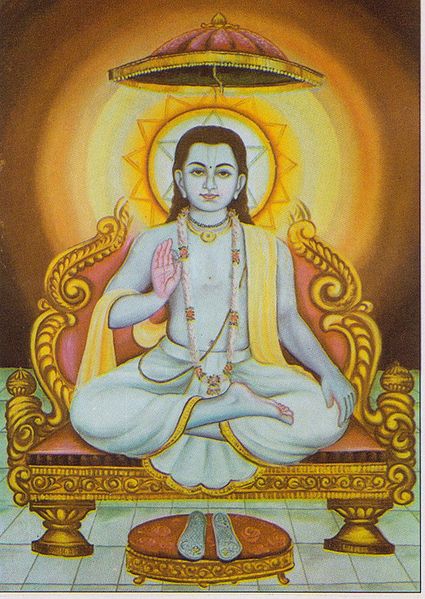International Nimbarka Society
Nimbarka Philosophy

Sri Sri Nimbarkacharya
There is much controversy among scholars as to the time of birth of Sri Nimbarka Dev. While most academic scholars date Sri Nimbarka Dev’s birth around 13th century, the Nimbarka Sampradaya largely maintains that he was born 5000 years ago in the present day Andhra Pradesh in India. It is said that when the world was tormented by darkness and people prayed for relief, Lord Vishnu (Sri Hari) sent his Sudarshan Chakra (his powerful disc like weapon) to the world as Sri Nimbarka Dev to spread light through teachings of Vaishnavism.
Born as Niyamananda, to Arun Muni, a hermit, and Jayati Devi, he showed signs of high intellect and profound devotion right from his childhood. Young Niyamananda was at home with his mother when Lord Brahma came in disguised as a simple hermit seeking food and shelter from the family. Niyamananda and his parents lived very simply and gathered only as much food as needed for the day. It was almost end of the day and there was no food left in the house for them to offer the hungry hermit. As guests are considered to be God himself, Niyamananda could not think of letting the hermit go hungry. So he asked the hermit to wait and went gathering fruits and roots to offer to the guest. When he returned with the food, the last rays of the sun were already fading in the distant horizon and as it stands hermits don’t eat anything after sundown. Young Niyamananda, determined to serve food to his guest, promised his guest that he won’t let the sun go down before the hermit completes his meal. So he prayed and invoked the Sudarshana Chakra as resplendent as the sun and placed it on the Neem tree near his house, which lit the sky like day time enabling the hermit to finish his meal. Pleased by his kindness and devotion Lord Brahma blessed him and named him Sri Nimbarkacharya. Later, Narda himself taught Sri Nimbarkacharya about Vaishnavism and indoctrinated him in the Gopala Mantra.
Different Vaishanava sects have different theories explaining the nature and relationship of God and his creations. Sri Nimbarkacharya came up with the theory of Dwaitadwaitabad that laid the foundation of Nimbarka Sampradaya. Dwaita means dual and Adwaita means unified or one. He suggested that all animate and inanimate objects are part of God and all souls are part of the Supreme Soul. Now the question arises, that if God is in all his creations, then why cannot his creations have the supreme unlimited power like God himself? He answered that as water changes its physical properties when its turns in to ice, similarly when the soul (the undying, untarnished spark of power, part of the Supreme Soul) is bound by the physical parameters of matter, it changes its properties. So the soul is bound within the body which is distracted by ‘Maya’ through its five senses. Controlling these senses and meditating with devotion clears this illusion of worldly ties and material world and helps in the realization of the truth that the soul is a part of the Supreme Soul.
Sources:
http://www.dlshq.org/saints/nimbarka.htm
http://www.sanatansociety.org/yoga_and_meditation/nimbarka_philosophy.htm
http://en.wikipedia.org/wiki/Nimbarka
http://shrijagatgurunimbarkacharyapeeth.org/index_files/NimbarkacharyaPeeth.htm
For feedback about the site, please email us at webmaster@internationalnimbarkasociety.org.